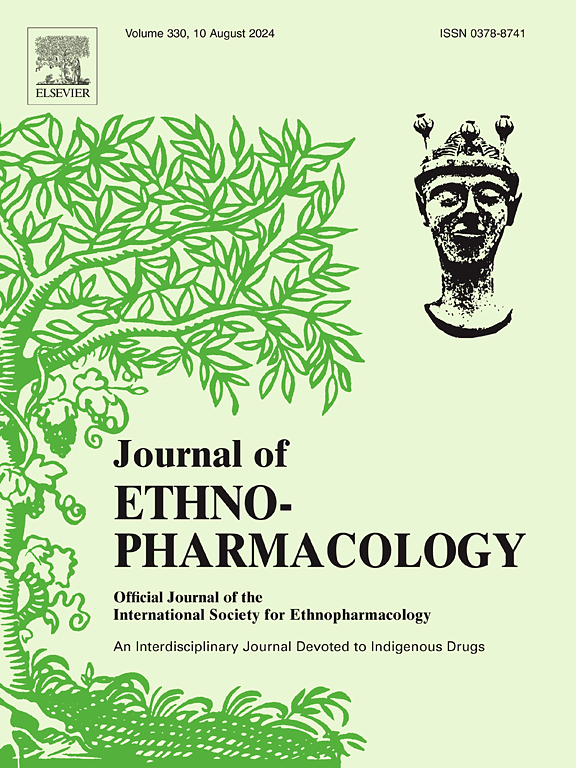Smilax china L. Rhizome extract enhances anti-tumor immune responses by resetting M2-like macrophages and tumor-associated macrophages to M1-like via ERK1/2 signaling
IF 4.8
2区 医学
Q1 CHEMISTRY, MEDICINAL
引用次数: 0
Abstract
Ethnopharmacological relevance
Smilax china L. is a traditional Chinese herb. Smilax china L. Rhizome (SCR) have historically been used in ethnomedicine for their anti-inflammatory, anti-tumor, and immunomodulatory properties.
Aim of the study
This study aimed to evaluate the anti-tumor efficacy of SCR in the MMTV-PyMT mouse mammary tumor model and elucidate its immunomodulatory mechanisms within the tumor microenvironment (TME).
Materials and methods
SCR was administered to MMTV-PyMT mice to assess its effects on tumor progression and metastasis. Immune cell profiling (M1/M2-like macrophages, CD8+ T cells) was conducted via flow cytometry. In vitro macrophage polarization assays under IL-4 stimulation and mechanistic studies (MAPK/ERK signaling) were performed using Western blot and pharmacological inhibitors. Diosgenin, a key SCR constituent, was identified and validated through phytochemical analysis and functional assays.
Results
SCR treatment significantly slowed primary tumor growth and reduced lung metastases. SCR induces a shift in macrophage polarization from immunosuppressive M2-like to proinflammatory M1-like and promotes increased CD8+ T cell infiltration. In vitro, SCR inhibited IL-4-induced M2 polarization and suppressed ERK1/2 phosphorylation, a critical node in the MAPK pathway. Diosgenin was identified as a pivotal bioactive compound contributing to SCR's anti-tumor and immunomodulatory effects.
Conclusions
These findings provide a theoretical basis for the potential clinical application of SCR in cancer treatment, highlighting its critical role in remodeling the tumor immune microenvironment.
菝葜提取物通过ERK1/2信号通路将m2样巨噬细胞和肿瘤相关巨噬细胞复位为m1样,从而增强抗肿瘤免疫应答。
民族药理学相关性:菝葜是一种传统中药。菝葜根茎(Smilax china L. Rhizome, SCR)因其抗炎、抗肿瘤和免疫调节的特性,历来被用作民族医药。研究目的:本研究旨在评价SCR在MMTV-PyMT小鼠乳腺肿瘤模型中的抗肿瘤作用,并阐明其在肿瘤微环境(tumor microenvironment, TME)内的免疫调节机制。材料和方法:将SCR用于MMTV-PyMT小鼠,评估其对肿瘤进展和转移的影响。免疫细胞谱分析(M1/ m2样巨噬细胞,CD8+ T细胞)通过流式细胞术进行。使用Western blot和药物抑制剂进行IL-4刺激下的巨噬细胞体外极化实验和机制研究(MAPK/ERK信号传导)。通过植物化学分析和功能分析,鉴定并验证了薯蓣皂苷元(Diosgenin)是SCR的关键成分。结果:SCR治疗显著减缓原发肿瘤生长,减少肺转移。SCR诱导巨噬细胞极化从免疫抑制的m2样向促炎的m1样转变,并促进CD8+ T细胞浸润增加。体外,SCR抑制il -4诱导的M2极化,抑制ERK1/2磷酸化,这是MAPK通路的关键节点。薯蓣皂苷元是一种具有抗肿瘤和免疫调节作用的重要生物活性化合物。结论:这些发现为SCR在肿瘤治疗中的潜在临床应用提供了理论基础,突出了其在肿瘤免疫微环境重塑中的关键作用。
本文章由计算机程序翻译,如有差异,请以英文原文为准。
求助全文
约1分钟内获得全文
求助全文
来源期刊

Journal of ethnopharmacology
医学-全科医学与补充医学
CiteScore
10.30
自引率
5.60%
发文量
967
审稿时长
77 days
期刊介绍:
The Journal of Ethnopharmacology is dedicated to the exchange of information and understandings about people''s use of plants, fungi, animals, microorganisms and minerals and their biological and pharmacological effects based on the principles established through international conventions. Early people confronted with illness and disease, discovered a wealth of useful therapeutic agents in the plant and animal kingdoms. The empirical knowledge of these medicinal substances and their toxic potential was passed on by oral tradition and sometimes recorded in herbals and other texts on materia medica. Many valuable drugs of today (e.g., atropine, ephedrine, tubocurarine, digoxin, reserpine) came into use through the study of indigenous remedies. Chemists continue to use plant-derived drugs (e.g., morphine, taxol, physostigmine, quinidine, emetine) as prototypes in their attempts to develop more effective and less toxic medicinals.
 求助内容:
求助内容: 应助结果提醒方式:
应助结果提醒方式:


